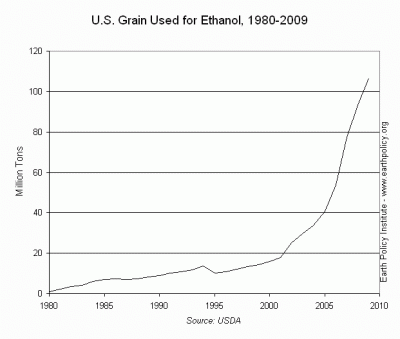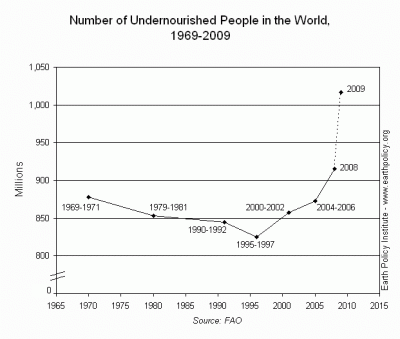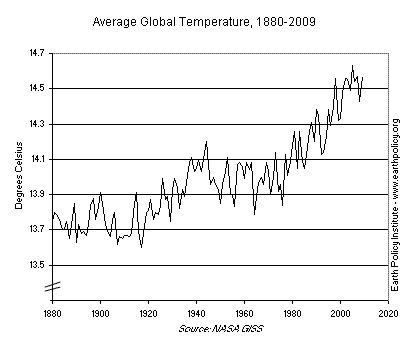EU Farmers Face Genetic Contamination of Seeds
BERLIN, Jan 29, 2010 (IPS) - Biodiversity, already decaying fast as a result of climate change and intensive farming, is under further threat by genetic modification (GM) of seeds, says a leading German ecological activist.
Genetic modification of seeds is dangerous, "since it is at the beginning of the agricultural chain, and can spread all over," says Benedikt Haerlin, former campaign manager at the environmental organisation Greenpeace and former member of the European Parliament.
Haerlin now leads the global ‘Save our Seeds’ campaign in cooperation with some 300 environmental organisations across Europe.
The campaign is currently calling attention to plans by the European Commission (EC) to tolerate "accidental or technically unavoidable" contamination of conventional seed with GM varieties.
In September 2004, the EC sought to pass a directive allowing up to 0.7 percent of GM organisms (GMO) in maize and oilseed rape seed without being labelled.
But fierce protests by organic farmers and environmental organisations forced the EC to withdraw the proposal. Since then, EC has not submitted any new recommendations.
Some commissioners, such as Stavros Dimas, who was in charge of environment between 2004 and 2009, have even questioned whether thresholds are necessary. Although the mandate for the present EC ended last October, Dimas is still serving as commissioner for environment until a new commission is approved and takes office.
"The official position of the EC remains, however, that a new proposal for the specification of threshold values for genetic contamination of seed is in the works," Haerlin told IPS.
Haerlin said that calling such contamination "accidental or technically unavoidable" with GMOs is misleading. "For fodder or even food, that genetic contamination under 0.9 percent is not declared can be acceptable," Haerlin explained. "At least, I can be sure that such contamination won't spread to other areas of life."
This is not the case with seeds, he said. "GM seeds can contaminate the fields of peasants and farmers who oppose them. After contamination, they would be forced to prove the origin of the pollution.
‘’Farmers using what they believe are organic seeds, but which have been genetically contaminated, would continue using part of the polluted crop as seeds for the next season, and multiply and spread the contamination, " he said.
"The most important impact of GM agriculture is on the social and economic conditions of farmers," Haerlin told IPS. "In general, GM agriculture makes farmers dependent on the big agrochemical business, and also provokes conflicts between peasants and landowners."
Haerlin accused the agrochemical giants that control the market for GM seeds to use "back doors and bad legislation to put their seeds on the market. They know that otherwise they would not sell their seeds."
Haerlin warned that research and development in agriculture is taking place "more and more only in the chemistry labs, and not on the field, and are concentrated in only a handful of companies." Because of this, organic, traditional seeds are disappearing, he said.
"The environmental consequences are enormous and extremely dangerous, and, once they have happened, it will be too late to turn back the tide," Haerlin said.
According to environmental and agriculture experts, 25 years ago there were at least 7,000 seed growers worldwide, and none of them controlled more than one percent of the global market.
Today, after a takeover spree, ten major biochemical multinationals, including Monsanto, DuPont-Pioneer, Syngenta, Bayer Cropscience, BASF and Dow Agrosciences, control more than 50 percent of the seeds market.
"The goal of these companies is, of course, to make profits," Haerlin told IPS. "In order to improve their profits, they all apply one strategy to increase their control of the market: they impose upon farmers worldwide the so-called vertical integration of inputs, from seeds to fertilisers to pesticides, all from one brand."
Such "vertical integration of agricultural inputs" has transformed agriculture in developing countries into a two-class business, Angelika Hillbeck, researcher on bio-safety and agriculture at the Swiss Federal Institute of Technology in Zurich, told IPS.
"In the developing countries there is a class of farmers with large plantations and enough money who can afford to buy all inputs from the major biochemical companies, from seeds and fertilisers to pesticides and conservatives,’’ she said.
But there are small farmers for whom the biochemical markets are out of reach. Additionally GM seeds have crowded out organic seeds, reduced botanical diversity, especially in developing countries, and contributed to a further decimation of biodiversity.
All European Union (EU) member countries have joined the United Nations campaign declaring 2010 ‘The Year of Biodiversity’ in an effort to emphasise the need to protect variety in flora and fauna. The U.N., which launched the campaign on Jan. 11 in Berlin, has recognised that the objective set in 2003 to stop the decimation of biodiversity by 2010 would not be reached.
This European engagement in favour of biodiversity appears to be only lip service to the environment cause since, in reality, European institutions support biochemical multinationals that are out to make genetic contamination legal.
Additionally, European institutions appear to have revolving doors connecting some of their leading officers to private biochemical and agribusiness companies - as the case of Suzy Renckens shows.
Renckens was until 2008 head of the European Food Safety Authority (EFSA)’s GMO Unit and coordinator of the European scientific expert panel dealing with GMOs. One month after she quit the EFSA, Renckens became head of Biotech Regulatory Affairs for Europe, Africa and Middle East at Syngenta, one of the largest European agribusiness companies.
In her own words, Renckens now lobbies on behalf of Syngenta to influence EU decision-making on genetically engineered organisms. This is the very same issue she was responsible for regulating while with the EFSA.
Haerlin said that ‘Save our Seeds’ has formulated a petition, addressed to the EC and other political authorities in Europe, calling for a ban of GMOs in seeds.
The petition, which has been so far signed by well over 200,000 citizens all over the EU, says that "the uncontrolled spread and propagation of GMOs is incompatible with the precautionary protection of the environment and human health."
The petition also says that "the purity of seeds has to be ensured by those who produce or wish to grow GMOs and not by those who wish to continue farming and consuming products without GMOs."
"Costs arising from this obligation must not be borne by consumers and certainly not by farmers," the petition adds. "Liabilities will have to be covered by the producers of GMOs. Such a guarantee may have to be ensured in other directives, regulations and legislation before the proposed directive enters into force."
The initiative ‘Save our Seeds’ is being coordinated by the Berlin-based Foundation on Future Farming, which primarily supports the development and breeding of organic seed.
(END)
Monsanto, the agricultural biotechnology company, genetically modified a variety of hard red spring wheat to resist the company's Roundup herbicide.
The environment and economy of the Northern Great Plains are threatened by the potential introduction of this genetically modified (GM) wheat. Questions about market acceptance, farmer liability, segregation, and risks to the environment and human health remain unanswered.
We are working to prevent the commercial introduction of GM wheat until these questions are answered.
In May 2004, Monsanto announced that it was shelving research and development on genetically modified (GM) wheat. The announcement followed five years of opposition by wheat farmers, consumers, and food safety activists to the commercial introduction of Roundup Ready wheat.
Market resistance to GM wheat
A 2003 report by Dr. Robert Wisner - a leading grain market economist at Iowa State University - shows the commercial introduction of genetically modified wheat in the next several years could cause major risk to the U.S. wheat industry.
<http://www.worc.org/userfiles/file/wisner-final-2003.pdf>
After examining data on existing markets, consumer trends, and grain handling and transportation systems, Dr. Wisner concluded that the commercial introduction of genetically modified wheat could result in the loss of 30% to 50% of U.S. spring wheat export markets, and a reduction of up to one-third in U.S. prices for hard red spring and durum wheat.
On August 23, 2006, WORC released a second update to the Market Risks report. The update found that consumer attitudes towards GM crops are unchanged. The update also responds to claims made by some U.S. wheat growers that GM wheat would reverse declining wheat acres.
<http://www.worc.org/userfiles/file/Wisner-Market%20Risks-Update-2006.pdf>
* Read WORC's news release for Dr. Wisner's response.
<http://www.worc.org/GM-Wheat-Wisner-report-2006/>
WORC issued a third update of the report by Dr. Neal Blue, a grain market consultant and former research economist at Ohio State Universityon January 27, 2010. A Review of the Potential Market Impacts of Commercializing GM Wheat in the U.S. concludes that wheat buyers in Europe, Japan, and other Asian countries are likely to switch to GM-free
wheat from other countries if GM wheat is introduced in this country. As a result, the price of U.S. hard red spring wheat would fall 40%, and the price of durum wheat would drop 57%.
<http://www.worc.org/userfiles/file/GM%20crops/Review_%
20of_Potential_Market_Impacts.pdf>
* Read news release of Dr. Blue's report.
<http://www.worc.org/userfiles/file/GM%20crops/
GMwheat_update_release_01_27_10.pdf>
--
GENET-forum
providing background information for the
European NGO Network on Genetic Engineering
contact:
Hartmut MEYER (Mr)
phone....... +49-531-5168746
fax......... +49-531-5168747
email....... hartmut.meyer(*)genet-info.org
skype....... hartmut_meyer
url......... www.genet-info.org









